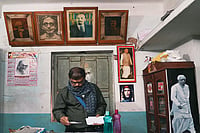Diwali has always been a time for renewal — a season when homes glow brighter, families gather, and traditions are honoured. Yet each year, the way we express this spirit of festivity evolves. In 2025, one trend is making a strong mark on festive interiors: eco-artisan design. It is a movement that marries sustainability with cultural authenticity, blending the warmth of heritage with the mindfulness of modern living.
The eco-artisan approach reflects a growing desire among homeowners to celebrate festivals without excess or waste. The focus is shifting from mass-produced, ornate décor to meaningful elements that carry a story — whether it’s a toran woven by hand, a diya crafted in clay, or block-printed textiles passed down from artisan clusters. This trend is not just aesthetic. It resonates with broader shifts in lifestyle, where conscious consumerism and sustainable choices are shaping decisions across industries. In the context of Diwali, a festival that symbolizes illumination and renewal, this design movement feels particularly relevant.
Eco-Artisan Interiors
At its heart, eco-artisan interiors emphasise natural materials, handcrafted details, and balance.
Natural & Recycled Materials: Furniture and accents made from reclaimed wood, jute, or banana fibre add texture while telling stories of reuse and reinvention.
Terracotta & Clay: Diyas, pots, and lampshades in earthy tones provide warmth and are fully biodegradable, aligning perfectly with the values of the season.
Minimal Lighting: Instead of the traditional rainbow of bulbs, single-tone amber or soft white fairy lights offer understated sophistication and reduce visual clutter.
Handwoven Textiles: Block prints, khadi cushions, or embroidered throws infuse a space with artisanal richness, turning everyday rooms into festive havens.
Biophilic Accents: Potted plants, woven planters, and natural greenery soften the sharpness of lights, creating balance between nature and design.
Subtle Metallic Touches: Brass or copper trays and candle holders add sparkle without dominating the overall scheme.
The beauty of this trend is how it translates across spaces, creating a unified story throughout the home.
Entrances & Foyers: A natural handwoven toran or mango-leaf garland at the doorway sets the tone, accompanied by simple rangoli patterns crafted from flowers or natural powders. These elements create an immediate sense of welcome and tradition.
Living Rooms: The centre of most Diwali gatherings, living rooms shine with block-printed cushions, airy woven curtains, and strings of fairy lights that frame celebrations with a warm, golden glow. Layering textures rather than colours create an atmosphere that feels both festive and sophisticated.
Pooja Corners: Here, the trend encourages restraint. Simple clay diyas, arranged in varying heights and lit with soft LED backlighting, rest on natural mats. This simplicity gives spiritual corners a grounded yet luminous quality.
Dining Spaces: Family meals and festive spreads look even more inviting when set against jute runners, terracotta centrepieces, and brassware. These small touches transform dining into a celebration of both tradition and design.
Balconies & Outdoor Corners: For homes with outdoor spaces, the eco-artisan trend encourages rustic lanterns, hanging clay lamps, and single-tone fairy lights intertwined with potted greenery. These create charming, intimate spaces for evening gatherings.
Practical Considerations
Like every design movement, the eco-artisan trend has its nuances. Natural materials can be fragile, requiring care to maintain. Handwoven textiles and artisanal objects often come at a premium compared to mass-produced alternatives. And because many of these items are sourced from local craft clusters, advance planning is essential during the festive rush. Yet these challenges also form part of the appeal. Each handcrafted object is unique, each diya or woven runner a reflection of tradition preserved through time. For homeowners, the investment is not just in décor, but in culture, sustainability, and storytelling. Safety, too, remains important. Certified LED lights and well-tested finishes ensure that the beauty of homes never comes at the expense of wellbeing.
Conclusion
Ultimately, eco-artisan interiors capture the true festive spirit of Diwali. They remind us that the festival is not only about how brightly a home can shine, but also about the values it reflects. By embracing sustainability and tradition in equal measure, this trend ensures that homes celebrate with light, elegance, and meaning. It is not just about illuminating spaces — it’s about illuminating choices. The eco-artisan movement proves that design can be festive, beautiful, and deeply conscious all at once.
Powered by Torbit Realty.




















